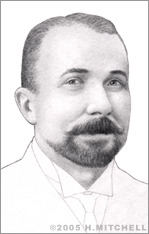Felix Hoffman
No doctor’s office or medicine cabinet is complete without a supply of aspirin, the world’s most popular and, in many ways, miraculous painkiller. This multi-purpose drug was first stabilized and patented during a three-year span from 1897 to 1900 by Felix Hoffman, a chemist with Friedrich Bayer & Co. in Germany.
Born on January 21, 1868 in Ludwigsburg, Germany, Hoffman studied pharmacy and chemistry at the University of Munich, from where he graduated in 1893 with a doctoral degree. In 1894, he began working as a chemist for Bayer in Elberfeld, Germany. His father’s suffering from the pain of arthritis inspired him to seek a chemical substance that could safely treat everyday pain.
Hoffman began studying historical records and research related to pain treatment, including works by Hippocrates, a Greek physician who lived in approximately 400 B.C. Documentation showed that medicines made from the bark and leaves of willow trees had been used since that time to treat pain and fever, and much later, in the early 19th century, a substance known as salicin found in willow plants was identified as the compound that had the power to relieve pain.
Between 1800 and 1835, chemists in Germany, France, and Italy were able to extract salicin, convert it into salicylic acid, and purify it for human consumption. However, in this form, it was very harsh on people’s stomachs. Later, in 1853, French researcher Charles Frederic Gerhardt found a way to neutralize it to some extent by combining it with sodium and acetyl chloride. His research stopped there, though, and no resulting product was ever fully developed.
In 1897, Hoffman rediscovered Gerhardt’s experiments and studied them carefully. He conducted similar experiments of his own. He sought a stable, buffered version of salicylic acid that his company would be able to commercialize on a grand scale. On August 10, 1897, he succeeded with this endeavor. By combining acetylating salicylic acid with acetic acid, he created acetylsalicylic acid, or ASA, with the desired characteristics for consumer use. The substance had the ability to relieve fever, pain, and inflammation, all without upsetting the patient’s stomach. Hoffman is said to have tested versions of the product on his father to find the safest and most effective solution and found that ASA worked best.
Bayer trademarked the name “Aspirin” in 1899 and quickly began a worldwide marketing campaign. Hoffman was promoted to director of pharmaceutical marketing. Bayer named the product using “A” for acetyl chloride, “spir” for spiraea ulmaria, the latin name for the plant that they derived salicylic acid from, and “in” as a popular suffix for medicines.
First, Bayer began distributing aspirin to doctors to give to their patients in a powdered formula. In 1900, Bayer introduced water-soluble tablets, representing the first-ever medication to be sold in this form. In 1915, prescriptions for aspirin became unnecessary. Before long, aspirin was the most popular drug in the world.
Germany refused to award a patent for the development of ASA, but the United States disagreed, granting Patent No. 644,077 to Hoffman and the Bayer Co. on Feb. 27, 1900. This gave Bayer a monopoly on aspirin from 1900 to 1917, after which rights were given up as part of Germany’s concessions included in the Treaty of Versailles following World War I.
Hoffman, meanwhile, lived a quiet life in spite of his groundbreaking discovery. Although he never made significant financial gains from it, aspirin changed the lives of millions of people around the world and fast became a staple in the over-the-counter drug market.
Hoffman died in Switzerland on Feb. 8, 1946.
It wasn’t until 1971 that the secrets of some of aspirin’s mysterious powers finally came to light. That year, scientist John Vane concluded that a chemical in aspirin blocked pain by inhibiting the development of prostaglandins, which play a role in stimulating processes in the body that lead to inflammation and the brain’s telling a site to feel pain. Vane was awarded the Nobel Prize for Medicine for work related to this discovery in 1982.
Additionally, aspirin was shown to help prevent heart attacks via research presented by Dr. Lawrence Craven in 1948, leading to the FDA’s decision 50 years later, in 1998, to expand the use of aspirin to include reducing risk of death during a suspected heart attack, as well as for preventing a recurrent stroke. Today, aspirin finds a multitude of uses, including the treatment of migraines, muscle pain and inflammation, arthritis, and even some cancers. In the United States alone, men, women, and children are estimated to ingest at least 15 million aspirin tablets per year.


